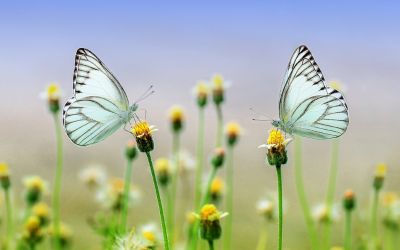Butterfly Gardening

Written by LaDonna Stockstill and Carol Welch
Which do you prefer: a flowerbed, or a show-stopping garden? Me, I want a little piece of paradise that captures the eye as well as the heart. I want the visitors to my garden to be just as spectacular as the flowers that live there. I want a thriving paradise that shelters some of the most beautiful of God’s creatures.
Creating a butterfly garden takes a little planning, but the process is both simple and enjoyable. You are creating more than a flower garden; you are creating a habitat for an insect that has a complex life cycle. Butterflies need an environment that provides every necessity including: food, shelter, sun and water.
One of the most important tips to keep in mind when planting your garden is diversity. Butterflies need a healthy, natural environment for each stage of life, from larva to butterfly. This means that you specifically plan for some of your plants to be eaten by hungry caterpillars. You scatter these host plants into the background, leaving room for more spectacular focal plants that will feed the adult butterflies.


Adult females will be visiting the garden throughout spring and summer looking for host plants capable of nourishing a hungry caterpillar. These are the plants that will be home for the tiny eggs. When the caterpillar hatches, the plant provides a feast that allows the caterpillar to grow and develop. While host plants fill a variety of spots in your garden, they should not be focal points. These plants will be less noticeable in the background. They will fill the spaces between beautiful shrubs and flowers, which will shelter the cocoons and provide nourishment to adult butterflies.
A successful garden will have a variety of colorful, nectar-rich flowers. Butterflies prefer flowers of particular shape and color. They like composite flowers (like daisies and marigold); cluster flowers (like butterfly bush and vitex); umbel flowers (like butterfly weed); single flowers (like daylilies); and vines with flowers across the surface (like honeysuckle). Butterflies prefer a variety of colors including: orange, pink, purple, red, yellow, and true blue. Because the garden is as much for your enjoyment as it is for the butterfly, choose colors and shapes that are pleasing to you. Organize your plants in groups and clusters that invite the butterflies to sit and stay for a while, giving you plenty of time to enjoy them.
In order to attract and nurture butterflies, it is critical to provide a pesticide free environment. The chemicals that kill annoying pests will also kill the fragile butterfly. As a result, your garden will require a little more work because you must remove pests the old fashioned way by washing them off with a water hose or picking them off by hand.
As you add to your garden each season, notice which plants your butterflies prefer. If they are drawn to a few particular plants, add more of those varieties to your landscape. Also, take note of the kinds of butterflies and caterpillars that visit your garden. Most caterpillars have only one preferred food source. If you want a greater variety of butterflies, you will need particular host plants for their caterpillars.
In addition to plants, butterfly habitats will need sunning areas, water and protection from wind. Because they are cold-blooded, butterflies are unable to fly on cold mornings. They require a protected.

Black Swallowtail
place in the sun to rest and warm their bodies. Providing gravel, logs, rocks or tree limbs in sunny areas will do nicely. They also require sheltered areas to rest during inclement weather and to hide from predators. Shelter plants include ornamental grasses, shrubs, small trees and vines.
Special water sources are also important. You may create puddles by mixing a little salt and sand in the bottom of a shallow pan and filling it with a small amount of water. This provides much needed nutrients and grit for the butterflies. Butterfly puddles can range in size and can be located in a variety of areas. Clean this habitat frequently.
Remember most butterflies are here year around. The monarch migrates, but others are here and need a resourceful habitat during the winter. Many butterflies spend the winter in a state of hibernation called diapause. As the weather warms to 60 degrees or higher, butterflies will come out of hiding in search of food. Having winter nectar sources in your yard is very important. Almost any plant that flowers during the winter will do. One of the best winter bloomers is winter honeysuckle. When flowers are unavailable, over-ripe fruit will provide for their needs.
There are several varieties of plants that are cold tolerant and can be planted in February (like anise hyssop, creeping phlox, and butterfly milkweed). When you do this, you will have an established, flowering plant by early spring when the butterflies become active. Make sure to plant both nectar plants as well as host plants for the caterpillars.
I’ve already discussed several plants, and here are a few more that come with the Parker County Master Gardener’s stamp of approval.
Annual: Cosmo, Pentas, Phlox, Plumbago, Dill, Fennel, Milk Weed, Parsley
Perennial: Aster, Black-Eyed Susan, Gregg’s Blue Mistflower, Daisy, Lantana, Phlox, Autumn Sage, Mealy Blue Sage,Butterfly Weed, Fall Aster, Lantana, Violet
Shrubs: Butterfly Bush, Cotoneaster, Privet, Vitex, False Indigo, Texas Sage
Trees: Carolina Buckthorn, Wild Plum Elm, Willow Vines Honeysuckle Passion Vine
Now that you have some specific details, it’s time for the fun to begin. Go on, get out there. Those butterflies are hungry!
